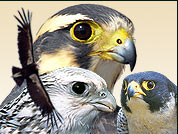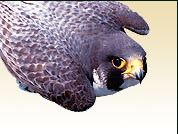Peregrine Falcon (Falco Peregrinus) Jonathan Lauterbach lauterba.jona@students.uwlax.edu
Site
- Home
- Habitat
- Nutrition
- Adaptations
- Reproduction
- Classification
- Interactions
- Fun Facts
- References
- About the Author
Links
Adaptations
 The Peregrine Falcon has feet with “claws”
on them that are especially adapted to holding on to their
prey. The peregrine also has adapted its
beak and muscles in the jaw. The beak has what is called a
Tomial tooth which it uses to snap the spinal cord of the
prey if it has not already died from the initial impact. The
muscles in the Peregrine Falcon jaw are very strong and are
also very adapted to snap the spinal cord of the prey, as
well as to eat its food. During the dive,
the pressure that is produced while travelling 200 mph could
damage the lungs and therefore the Peregrine Falcon has
developed small tubercles to guide the air so that it does
not do harm to the lungs.
The Peregrine Falcon has feet with “claws”
on them that are especially adapted to holding on to their
prey. The peregrine also has adapted its
beak and muscles in the jaw. The beak has what is called a
Tomial tooth which it uses to snap the spinal cord of the
prey if it has not already died from the initial impact. The
muscles in the Peregrine Falcon jaw are very strong and are
also very adapted to snap the spinal cord of the prey, as
well as to eat its food. During the dive,
the pressure that is produced while travelling 200 mph could
damage the lungs and therefore the Peregrine Falcon has
developed small tubercles to guide the air so that it does
not do harm to the lungs.
